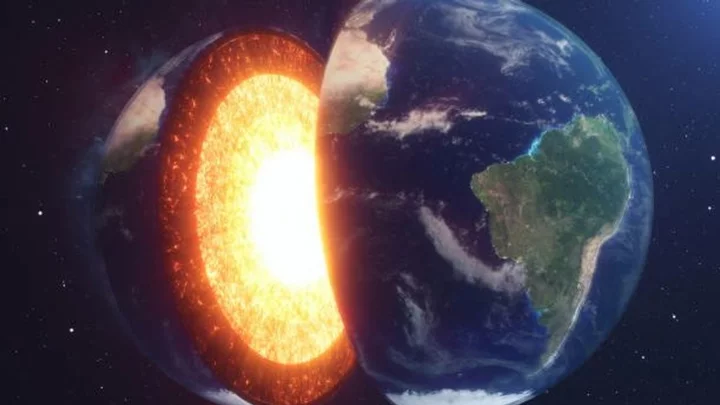Hidden structure discovered in Earth's core could 'rewrite' scientist's understanding of the planet
Scientists think they have discovered a previously unknown hidden structure inside the Earth’s core that could change our understanding of our planet. In school, most of us were taught there are four main layers to the Earth’s structure: the crust, the mantle, the outer core and the inner core. What we know about the Earth’s insides has mostly derived from geologists’ knowledge and observations of volcanoes and seismic waves. But now, scientists believe that there may also be a whole extra layer hidden inside the inner core that no one knew about. Earth’s molten inner core is predicted to be around 5,000 degrees Celsius in temperature and scientists have calculated that it takes up around just 1 per cent of the planet’s total volume. The discovery of a potential fifth layer to the planet’s core came a few years ago when scientists used an algorithm to model thousands of scenarios of the inner core to observe the length of time it takes seismic waves to travel through Earth based on data by the International Seismological Centre. Sign up to our new free Indy100 weekly newsletter Scientists were able to analyse how different material properties within the inner core would affect seismic waves differently and found that some scenarios were certainly more likely than others. The algorithm showed how different materials altered the angle of seismic waves, leading them to hypothesise that there was a change of material somewhere in the inner core. Joanne Stephenson, an Australian National University geophysicist, explained: “We found evidence that may indicate a change in the structure of iron, which suggests perhaps two separate cooling events in Earth's history.” She continued: “The details of this big event are still a bit of a mystery, but we've added another piece of the puzzle when it comes to our knowledge of the Earth's inner core.” While their data isn’t conclusive, it does correlate with other similar studies that have looked into the anisotropy of the Earth’s inner core. Stephenson said: “It's very exciting - and might mean we have to re-write the textbooks!” Have your say in our news democracy. Click the upvote icon at the top of the page to help raise this article through the indy100 rankings.
Scientists think they have discovered a previously unknown hidden structure inside the Earth’s core that could change our understanding of our planet.
In school, most of us were taught there are four main layers to the Earth’s structure: the crust, the mantle, the outer core and the inner core.
What we know about the Earth’s insides has mostly derived from geologists’ knowledge and observations of volcanoes and seismic waves. But now, scientists believe that there may also be a whole extra layer hidden inside the inner core that no one knew about.
Earth’s molten inner core is predicted to be around 5,000 degrees Celsius in temperature and scientists have calculated that it takes up around just 1 per cent of the planet’s total volume.
The discovery of a potential fifth layer to the planet’s core came a few years ago when scientists used an algorithm to model thousands of scenarios of the inner core to observe the length of time it takes seismic waves to travel through Earth based on data by the International Seismological Centre.
Sign up to our new free Indy100 weekly newsletter
Scientists were able to analyse how different material properties within the inner core would affect seismic waves differently and found that some scenarios were certainly more likely than others.
The algorithm showed how different materials altered the angle of seismic waves, leading them to hypothesise that there was a change of material somewhere in the inner core.
Joanne Stephenson, an Australian National University geophysicist, explained: “We found evidence that may indicate a change in the structure of iron, which suggests perhaps two separate cooling events in Earth's history.”
She continued: “The details of this big event are still a bit of a mystery, but we've added another piece of the puzzle when it comes to our knowledge of the Earth's inner core.”
While their data isn’t conclusive, it does correlate with other similar studies that have looked into the anisotropy of the Earth’s inner core.
Stephenson said: “It's very exciting - and might mean we have to re-write the textbooks!”
Have your say in our news democracy. Click the upvote icon at the top of the page to help raise this article through the indy100 rankings.

